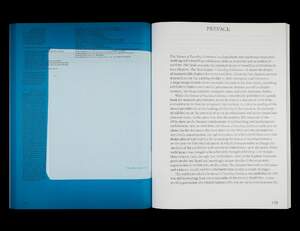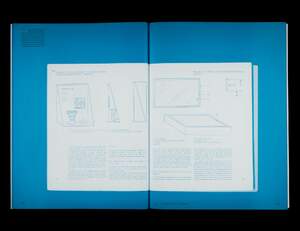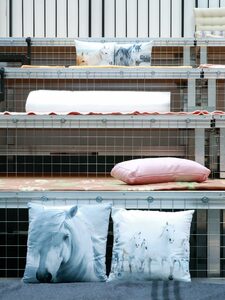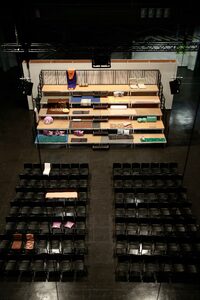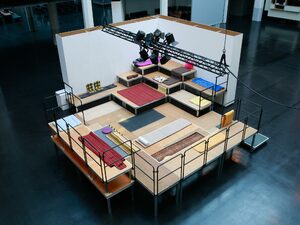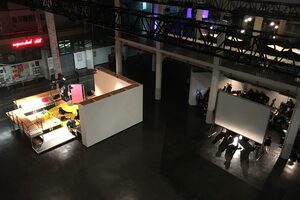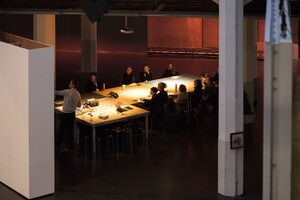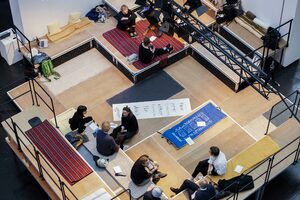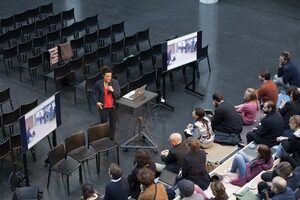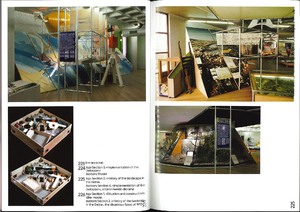"Wintersemester 2018/2019"
| Begriff | Wintersemester 2018/2019 |
| Metakey | Semester (institution:semester) |
| Typ | Keyword |
| Vokabular | HfG |
189 Inhalte
- Seite 1 von 16
Re-reading the Manual of Travelling Exhibitions, UNESCO 1953
- Titel
- Re-reading the Manual of Travelling Exhibitions, UNESCO 1953
- Titel (en)
- Re-reading the Manual of Travelling Exhibitions, UNESCO 1953
- Autor/in
- Beschreibung (de)
-
Das 1953 von der UNESCO herausgegebene "Manual of Travelling Exhibitions" ist ein Handbuch zur Organisation von Wanderausstellungen. An Museen und andere öffentliche Institutionen gerichtet, formuliert es eine Grammatik des Ausstellens: von organisatorischen Fragen bis zum Ausstellungsdesign. Das „Manual“ liest sich aus heutiger Sicht wie ein Manifest einer noch ungebrochenen Moderne der unmittelbaren Nachkriegszeit.
Ein umfangreich kommentierter Reprint des "Manual of Travelling Exhibitions" soll zum einen die historische Quelle kontextualisieren und kritisch hinterfragen, zum anderen verschiedene Formen der Aktualisierung aufzeigen. Dabei sind die Inhalte des „Manual“ ebenso bedeutsam wie seine immanenten Fehlstellen, die Buchgestaltung oder die fotografische Logik der Abbildungen.
-
- Beschreibung (en)
- "The Manual of Travelling Exhibitions" published by UNESCO in 1953 is a handbook on organizing touring exhibitions. Aimed at museums and other public institutions, it formulates a “grammar” of how to exhibit, ranging from organizational questions to reflections on exhibition design. From today’s perspective the manual reads like the manifesto of a modernity whose continuity was still unbroken in the immediate post-war period. This extensively annotated reprint of the "Manual of Travelling Exhibitions" is intended, on the one hand, to contextualize and critically examine the historical source and, on the other, to show different ways of updating it. The contents of the manual share the same importance as the inherent gaps it contains, the book’s design, and the photographic logic of the images.
- Typ des Projekts/Werks
- Schlagworte
- Datierung
- November 2018
- Mitwirkende
- Dank an
- Sprache
- Abmessungen
- 23,5 x 31 cm
- Stadt
- Land
- Internetlinks
- Bemerkungen
-
247 Seiten
Reproduktion des Originals und 20 weitere Abbildungen
fadengeheftete Broschur
ISBN: 9783959051361
Spector Books
Designer: Lena Thomaka, Johannes Hucht
Text: Martin Beck, Clémentine Deliss, Kurt Eckert, Jochen Eisenbrand, Rike Franke, Helene Hermann, Lydia Kähny, Tina Köhler, Moritz Küng, Sophie Lichtenberg, Jonathan Maho, Vanessa Joan Müller, Andreas Müller, Jennifer Tobias, Gitte Villesen, Nader Vossoughian, Florian Walzel, Grant Watson, Joanna Weddell, Maxim Weirich, Aaron Werbick
Herausgebende: Andreas Müller, Lydia Kähny, Sophie Lichtenberg, Aaron Werbick, Maxim Weirich
-
- Titel
- Re-reading the Manual of Travelling Exhibitions, UNESCO 1953
- Urheberrechtshinweis
- Andreas Müller, Lydia Kähny, Sophie Lichtenberg, Aaron Werbick, Maxim Weirich; Verlag: Spector Books; Grafik: Johannes Hucht, Lena Thomaka
- Rechtsschutz/Lizenz
- Beziehung/Funktion
- Projektleiter/in
- Semester
- Lehrveranstaltung
- Importiert am
- 29.06.2023
- Übergeordnete Sets
- 1
Re-reading the Manual of Travelling Exhibitions, UNESCO 1953
- Titel
- Re-reading the Manual of Travelling Exhibitions, UNESCO 1953
- Titel (en)
- Re-reading the Manual of Travelling Exhibitions, UNESCO 1953
- Autor/in
- Beschreibung (de)
-
Das 1953 von der UNESCO herausgegebene "Manual of Travelling Exhibitions" ist ein Handbuch zur Organisation von Wanderausstellungen. An Museen und andere öffentliche Institutionen gerichtet, formuliert es eine Grammatik des Ausstellens: von organisatorischen Fragen bis zum Ausstellungsdesign. Das „Manual“ liest sich aus heutiger Sicht wie ein Manifest einer noch ungebrochenen Moderne der unmittelbaren Nachkriegszeit.
Ein umfangreich kommentierter Reprint des "Manual of Travelling Exhibitions" soll zum einen die historische Quelle kontextualisieren und kritisch hinterfragen, zum anderen verschiedene Formen der Aktualisierung aufzeigen. Dabei sind die Inhalte des „Manual“ ebenso bedeutsam wie seine immanenten Fehlstellen, die Buchgestaltung oder die fotografische Logik der Abbildungen.
-
- Beschreibung (en)
- "The Manual of Travelling Exhibitions" published by UNESCO in 1953 is a handbook on organizing touring exhibitions. Aimed at museums and other public institutions, it formulates a “grammar” of how to exhibit, ranging from organizational questions to reflections on exhibition design. From today’s perspective the manual reads like the manifesto of a modernity whose continuity was still unbroken in the immediate post-war period. This extensively annotated reprint of the "Manual of Travelling Exhibitions" is intended, on the one hand, to contextualize and critically examine the historical source and, on the other, to show different ways of updating it. The contents of the manual share the same importance as the inherent gaps it contains, the book’s design, and the photographic logic of the images.
- Typ des Projekts/Werks
- Schlagworte
- Datierung
- November 2018
- Mitwirkende
- Dank an
- Sprache
- Abmessungen
- 23,5 x 31 cm
- Stadt
- Land
- Internetlinks
- Bemerkungen
-
247 Seiten
Reproduktion des Originals und 20 weitere Abbildungen
fadengeheftete Broschur
ISBN: 9783959051361
Spector Books
Designer: Lena Thomaka, Johannes Hucht
Text: Martin Beck, Clémentine Deliss, Kurt Eckert, Jochen Eisenbrand, Rike Franke, Helene Hermann, Lydia Kähny, Tina Köhler, Moritz Küng, Sophie Lichtenberg, Jonathan Maho, Vanessa Joan Müller, Andreas Müller, Jennifer Tobias, Gitte Villesen, Nader Vossoughian, Florian Walzel, Grant Watson, Joanna Weddell, Maxim Weirich, Aaron Werbick
Herausgebende: Andreas Müller, Lydia Kähny, Sophie Lichtenberg, Aaron Werbick, Maxim Weirich
-
- Titel
- Re-reading the Manual of Travelling Exhibitions, UNESCO 1953
- Urheberrechtshinweis
- Andreas Müller, Lydia Kähny, Sophie Lichtenberg, Aaron Werbick, Maxim Weirich; Verlag: Spector Books; Grafik: Johannes Hucht, Lena Thomaka
- Rechtsschutz/Lizenz
- Beziehung/Funktion
- Projektleiter/in
- Semester
- Lehrveranstaltung
- Importiert am
- 29.06.2023
- Übergeordnete Sets
- 1
Re-reading the Manual of Travelling Exhibitions, UNESCO 1953
- Titel
- Re-reading the Manual of Travelling Exhibitions, UNESCO 1953
- Titel (en)
- Re-reading the Manual of Travelling Exhibitions, UNESCO 1953
- Autor/in
- Beschreibung (de)
-
Das 1953 von der UNESCO herausgegebene "Manual of Travelling Exhibitions" ist ein Handbuch zur Organisation von Wanderausstellungen. An Museen und andere öffentliche Institutionen gerichtet, formuliert es eine Grammatik des Ausstellens: von organisatorischen Fragen bis zum Ausstellungsdesign. Das „Manual“ liest sich aus heutiger Sicht wie ein Manifest einer noch ungebrochenen Moderne der unmittelbaren Nachkriegszeit.
Ein umfangreich kommentierter Reprint des "Manual of Travelling Exhibitions" soll zum einen die historische Quelle kontextualisieren und kritisch hinterfragen, zum anderen verschiedene Formen der Aktualisierung aufzeigen. Dabei sind die Inhalte des „Manual“ ebenso bedeutsam wie seine immanenten Fehlstellen, die Buchgestaltung oder die fotografische Logik der Abbildungen.
-
- Beschreibung (en)
- "The Manual of Travelling Exhibitions" published by UNESCO in 1953 is a handbook on organizing touring exhibitions. Aimed at museums and other public institutions, it formulates a “grammar” of how to exhibit, ranging from organizational questions to reflections on exhibition design. From today’s perspective the manual reads like the manifesto of a modernity whose continuity was still unbroken in the immediate post-war period. This extensively annotated reprint of the "Manual of Travelling Exhibitions" is intended, on the one hand, to contextualize and critically examine the historical source and, on the other, to show different ways of updating it. The contents of the manual share the same importance as the inherent gaps it contains, the book’s design, and the photographic logic of the images.
- Typ des Projekts/Werks
- Schlagworte
- Datierung
- November 2018
- Mitwirkende
- Dank an
- Sprache
- Abmessungen
- 23,5 x 31 cm
- Stadt
- Land
- Internetlinks
- Bemerkungen
-
247 Seiten
Reproduktion des Originals und 20 weitere Abbildungen
fadengeheftete Broschur
ISBN: 9783959051361
Spector Books
Designer: Lena Thomaka, Johannes Hucht
Text: Martin Beck, Clémentine Deliss, Kurt Eckert, Jochen Eisenbrand, Rike Franke, Helene Hermann, Lydia Kähny, Tina Köhler, Moritz Küng, Sophie Lichtenberg, Jonathan Maho, Vanessa Joan Müller, Andreas Müller, Jennifer Tobias, Gitte Villesen, Nader Vossoughian, Florian Walzel, Grant Watson, Joanna Weddell, Maxim Weirich, Aaron Werbick
Herausgebende: Andreas Müller, Lydia Kähny, Sophie Lichtenberg, Aaron Werbick, Maxim Weirich
-
- Titel
- Re-reading the Manual of Travelling Exhibitions, UNESCO 1953
- Urheberrechtshinweis
- Andreas Müller, Lydia Kähny, Sophie Lichtenberg, Aaron Werbick, Maxim Weirich; Verlag: Spector Books; Grafik: Johannes Hucht, Lena Thomaka
- Rechtsschutz/Lizenz
- Beziehung/Funktion
- Projektleiter/in
- Semester
- Lehrveranstaltung
- Importiert am
- 29.06.2023
- Übergeordnete Sets
- 1
Matters of Communication
- Titel
- Matters of Communication
- Titel (en)
- Matters of Communication
- Untertitel
- 15th annual meeting of the German Society for Design Theory and Research
- Untertitel des Projekts/Werks (en)
- 15th annual meeting of the German Society for Design Theory and Research
- Autor/in
- Beschreibung (de)
- Ob Raum, Bild, Text, Objekt oder System - Design ist immer auch Kommunikation. Vor dem Hintergrund der zunehmenden Radikalisierung, Segmentierung und Polemisierung gesellschaftlicher Diskurse scheint das Verhältnis von Design und Kommunikation heute brisanter denn je. Ständig entstehen neue Kommunikationsmedien, -kanäle, -räume und -systeme. Maschinen, Objekte, ja ganze Umgebungen werden zu eigenständigen Akteuren, die mit uns kommunizieren und auf verschiedenen medialen Ebenen interagieren. Wie können wir die Kontexte, die Möglichkeitsbedingungen und Wirkungszusammenhänge im Hinblick auf gestaltete Kommunikation ausloten? Welche Konzepte werden benötigt, um das Verhältnis von Design und Kommunikation aus heutiger Sicht zu konzeptualisieren?
Die DGTF-Konferenz "Matters of Communication" schafft einen Raum für die Diskussion darüber, wie Kommunikation heute gestaltet wird und wie Design heute kommuniziert wird. Welches sind die wegweisenden Ansätze und Methoden der Designforschung in Bezug auf Kommunikation durch und in zeitgenössischen Ausdrucksformen sowie kultureller und wirtschaftlicher Produktion? Wie reflektieren Forschungsprojekte "Matters of Communication", d.h. die Form und Materialität gestalteter Kommunikation, und ihre Rolle bei der Entstehung von Zuschreibungen und Interpretationskontexten? Welche Rolle spielt die Designforschung bei der Entwicklung von relevanten Fragestellungen und Lösungen? Wie erfolgt die Theoriebildung und Umsetzung in Lehre und Praxis?
- Ob Raum, Bild, Text, Objekt oder System - Design ist immer auch Kommunikation. Vor dem Hintergrund der zunehmenden Radikalisierung, Segmentierung und Polemisierung gesellschaftlicher Diskurse scheint das Verhältnis von Design und Kommunikation heute brisanter denn je. Ständig entstehen neue Kommunikationsmedien, -kanäle, -räume und -systeme. Maschinen, Objekte, ja ganze Umgebungen werden zu eigenständigen Akteuren, die mit uns kommunizieren und auf verschiedenen medialen Ebenen interagieren. Wie können wir die Kontexte, die Möglichkeitsbedingungen und Wirkungszusammenhänge im Hinblick auf gestaltete Kommunikation ausloten? Welche Konzepte werden benötigt, um das Verhältnis von Design und Kommunikation aus heutiger Sicht zu konzeptualisieren?
- Beschreibung (en)
- Whether space, image, text, object or system — design is always also communication. Against the backdrop of increasing radicalization, segmentation and polemization of social discourses, the relationship between design and communication seems more volatile today than ever. New communications media, channels, spaces and systems are constantly emerging. Machines, objects, even entire environments become independent actors that communicate with us and interact on various media levels. How can we sound out the contexts, the conditions that lead to possibility and the interdependencies of impact with regard to designed communication? What concepts are needed to conceptualize the relationship between design and communication from a present-day point of view?
The DGTF conference “Matters of Communication” creates a space for discussion about how communication is designed today and how design is communicated today. What are the pioneering approaches and methods of design research in relation to communication through and within contemporary forms of expression, as well as cultural and economic production? How do research projects reflect “Matters of Communication”, i.e. the form and materiality of designed communication, and their role in the emergence of attributions and interpretation contexts? What is the role that design research plays in the development of relevant questions and solutions? How is theory formation and translation into teaching and practice carried out?
- Whether space, image, text, object or system — design is always also communication. Against the backdrop of increasing radicalization, segmentation and polemization of social discourses, the relationship between design and communication seems more volatile today than ever. New communications media, channels, spaces and systems are constantly emerging. Machines, objects, even entire environments become independent actors that communicate with us and interact on various media levels. How can we sound out the contexts, the conditions that lead to possibility and the interdependencies of impact with regard to designed communication? What concepts are needed to conceptualize the relationship between design and communication from a present-day point of view?
- Typ des Projekts/Werks
- Schlagworte
- Datierung
- 16.11.2018 - 18.11.2018
- Mitwirkende
- Sprache
- Ort: Institution
- Ort
- Lichthöfe
- Stadt
- Land
- Beteiligte Institution(en)
- Internetlinks
- Bemerkungen
- Graphik-Design: Lena Haselmann and Catharina Grözinger, © DGTF
- Titel
- Matters of Communication
- Urheberrechtshinweis
- Vera Gärtner, Jana Hofmann, Calvin Kudufia
- Rechtsschutz/Lizenz
- Medienersteller/in
- Projektleiter/in
- Semester
- Lehrveranstaltung
- Importiert am
- 21.06.2023
- Übergeordnete Sets
- 1
Matters of Communication
- Titel
- Matters of Communication
- Titel (en)
- Matters of Communication
- Untertitel
- 15th annual meeting of the German Society for Design Theory and Research
- Untertitel des Projekts/Werks (en)
- 15th annual meeting of the German Society for Design Theory and Research
- Autor/in
- Beschreibung (de)
- Ob Raum, Bild, Text, Objekt oder System - Design ist immer auch Kommunikation. Vor dem Hintergrund der zunehmenden Radikalisierung, Segmentierung und Polemisierung gesellschaftlicher Diskurse scheint das Verhältnis von Design und Kommunikation heute brisanter denn je. Ständig entstehen neue Kommunikationsmedien, -kanäle, -räume und -systeme. Maschinen, Objekte, ja ganze Umgebungen werden zu eigenständigen Akteuren, die mit uns kommunizieren und auf verschiedenen medialen Ebenen interagieren. Wie können wir die Kontexte, die Möglichkeitsbedingungen und Wirkungszusammenhänge im Hinblick auf gestaltete Kommunikation ausloten? Welche Konzepte werden benötigt, um das Verhältnis von Design und Kommunikation aus heutiger Sicht zu konzeptualisieren?
Die DGTF-Konferenz "Matters of Communication" schafft einen Raum für die Diskussion darüber, wie Kommunikation heute gestaltet wird und wie Design heute kommuniziert wird. Welches sind die wegweisenden Ansätze und Methoden der Designforschung in Bezug auf Kommunikation durch und in zeitgenössischen Ausdrucksformen sowie kultureller und wirtschaftlicher Produktion? Wie reflektieren Forschungsprojekte "Matters of Communication", d.h. die Form und Materialität gestalteter Kommunikation, und ihre Rolle bei der Entstehung von Zuschreibungen und Interpretationskontexten? Welche Rolle spielt die Designforschung bei der Entwicklung von relevanten Fragestellungen und Lösungen? Wie erfolgt die Theoriebildung und Umsetzung in Lehre und Praxis?
- Ob Raum, Bild, Text, Objekt oder System - Design ist immer auch Kommunikation. Vor dem Hintergrund der zunehmenden Radikalisierung, Segmentierung und Polemisierung gesellschaftlicher Diskurse scheint das Verhältnis von Design und Kommunikation heute brisanter denn je. Ständig entstehen neue Kommunikationsmedien, -kanäle, -räume und -systeme. Maschinen, Objekte, ja ganze Umgebungen werden zu eigenständigen Akteuren, die mit uns kommunizieren und auf verschiedenen medialen Ebenen interagieren. Wie können wir die Kontexte, die Möglichkeitsbedingungen und Wirkungszusammenhänge im Hinblick auf gestaltete Kommunikation ausloten? Welche Konzepte werden benötigt, um das Verhältnis von Design und Kommunikation aus heutiger Sicht zu konzeptualisieren?
- Beschreibung (en)
- Whether space, image, text, object or system — design is always also communication. Against the backdrop of increasing radicalization, segmentation and polemization of social discourses, the relationship between design and communication seems more volatile today than ever. New communications media, channels, spaces and systems are constantly emerging. Machines, objects, even entire environments become independent actors that communicate with us and interact on various media levels. How can we sound out the contexts, the conditions that lead to possibility and the interdependencies of impact with regard to designed communication? What concepts are needed to conceptualize the relationship between design and communication from a present-day point of view?
The DGTF conference “Matters of Communication” creates a space for discussion about how communication is designed today and how design is communicated today. What are the pioneering approaches and methods of design research in relation to communication through and within contemporary forms of expression, as well as cultural and economic production? How do research projects reflect “Matters of Communication”, i.e. the form and materiality of designed communication, and their role in the emergence of attributions and interpretation contexts? What is the role that design research plays in the development of relevant questions and solutions? How is theory formation and translation into teaching and practice carried out?
- Whether space, image, text, object or system — design is always also communication. Against the backdrop of increasing radicalization, segmentation and polemization of social discourses, the relationship between design and communication seems more volatile today than ever. New communications media, channels, spaces and systems are constantly emerging. Machines, objects, even entire environments become independent actors that communicate with us and interact on various media levels. How can we sound out the contexts, the conditions that lead to possibility and the interdependencies of impact with regard to designed communication? What concepts are needed to conceptualize the relationship between design and communication from a present-day point of view?
- Typ des Projekts/Werks
- Schlagworte
- Datierung
- 16.11.2018 - 18.11.2018
- Mitwirkende
- Sprache
- Ort: Institution
- Ort
- Lichthöfe
- Stadt
- Land
- Beteiligte Institution(en)
- Internetlinks
- Bemerkungen
- Graphik-Design: Lena Haselmann and Catharina Grözinger, © DGTF
- Titel
- Matters of Communication
- Urheberrechtshinweis
- Vera Gärtner, Jana Hofmann, Calvin Kudufia
- Rechtsschutz/Lizenz
- Medienersteller/in
- Projektleiter/in
- Semester
- Lehrveranstaltung
- Importiert am
- 21.06.2023
- Übergeordnete Sets
- 1
Matters of Communication
- Titel
- Matters of Communication
- Titel (en)
- Matters of Communication
- Untertitel
- 15th annual meeting of the German Society for Design Theory and Research
- Untertitel des Projekts/Werks (en)
- 15th annual meeting of the German Society for Design Theory and Research
- Autor/in
- Beschreibung (de)
- Ob Raum, Bild, Text, Objekt oder System - Design ist immer auch Kommunikation. Vor dem Hintergrund der zunehmenden Radikalisierung, Segmentierung und Polemisierung gesellschaftlicher Diskurse scheint das Verhältnis von Design und Kommunikation heute brisanter denn je. Ständig entstehen neue Kommunikationsmedien, -kanäle, -räume und -systeme. Maschinen, Objekte, ja ganze Umgebungen werden zu eigenständigen Akteuren, die mit uns kommunizieren und auf verschiedenen medialen Ebenen interagieren. Wie können wir die Kontexte, die Möglichkeitsbedingungen und Wirkungszusammenhänge im Hinblick auf gestaltete Kommunikation ausloten? Welche Konzepte werden benötigt, um das Verhältnis von Design und Kommunikation aus heutiger Sicht zu konzeptualisieren?
Die DGTF-Konferenz "Matters of Communication" schafft einen Raum für die Diskussion darüber, wie Kommunikation heute gestaltet wird und wie Design heute kommuniziert wird. Welches sind die wegweisenden Ansätze und Methoden der Designforschung in Bezug auf Kommunikation durch und in zeitgenössischen Ausdrucksformen sowie kultureller und wirtschaftlicher Produktion? Wie reflektieren Forschungsprojekte "Matters of Communication", d.h. die Form und Materialität gestalteter Kommunikation, und ihre Rolle bei der Entstehung von Zuschreibungen und Interpretationskontexten? Welche Rolle spielt die Designforschung bei der Entwicklung von relevanten Fragestellungen und Lösungen? Wie erfolgt die Theoriebildung und Umsetzung in Lehre und Praxis?
- Ob Raum, Bild, Text, Objekt oder System - Design ist immer auch Kommunikation. Vor dem Hintergrund der zunehmenden Radikalisierung, Segmentierung und Polemisierung gesellschaftlicher Diskurse scheint das Verhältnis von Design und Kommunikation heute brisanter denn je. Ständig entstehen neue Kommunikationsmedien, -kanäle, -räume und -systeme. Maschinen, Objekte, ja ganze Umgebungen werden zu eigenständigen Akteuren, die mit uns kommunizieren und auf verschiedenen medialen Ebenen interagieren. Wie können wir die Kontexte, die Möglichkeitsbedingungen und Wirkungszusammenhänge im Hinblick auf gestaltete Kommunikation ausloten? Welche Konzepte werden benötigt, um das Verhältnis von Design und Kommunikation aus heutiger Sicht zu konzeptualisieren?
- Beschreibung (en)
- Whether space, image, text, object or system — design is always also communication. Against the backdrop of increasing radicalization, segmentation and polemization of social discourses, the relationship between design and communication seems more volatile today than ever. New communications media, channels, spaces and systems are constantly emerging. Machines, objects, even entire environments become independent actors that communicate with us and interact on various media levels. How can we sound out the contexts, the conditions that lead to possibility and the interdependencies of impact with regard to designed communication? What concepts are needed to conceptualize the relationship between design and communication from a present-day point of view?
The DGTF conference “Matters of Communication” creates a space for discussion about how communication is designed today and how design is communicated today. What are the pioneering approaches and methods of design research in relation to communication through and within contemporary forms of expression, as well as cultural and economic production? How do research projects reflect “Matters of Communication”, i.e. the form and materiality of designed communication, and their role in the emergence of attributions and interpretation contexts? What is the role that design research plays in the development of relevant questions and solutions? How is theory formation and translation into teaching and practice carried out?
- Whether space, image, text, object or system — design is always also communication. Against the backdrop of increasing radicalization, segmentation and polemization of social discourses, the relationship between design and communication seems more volatile today than ever. New communications media, channels, spaces and systems are constantly emerging. Machines, objects, even entire environments become independent actors that communicate with us and interact on various media levels. How can we sound out the contexts, the conditions that lead to possibility and the interdependencies of impact with regard to designed communication? What concepts are needed to conceptualize the relationship between design and communication from a present-day point of view?
- Typ des Projekts/Werks
- Schlagworte
- Datierung
- 16.11.2018 - 18.11.2018
- Mitwirkende
- Sprache
- Ort: Institution
- Ort
- Lichthöfe
- Stadt
- Land
- Beteiligte Institution(en)
- Internetlinks
- Bemerkungen
- Graphik-Design: Lena Haselmann and Catharina Grözinger, © DGTF
- Titel
- Matters of Communication
- Urheberrechtshinweis
- Vera Gärtner, Jana Hofmann, Calvin Kudufia
- Rechtsschutz/Lizenz
- Medienersteller/in
- Projektleiter/in
- Semester
- Lehrveranstaltung
- Importiert am
- 21.06.2023
- Übergeordnete Sets
- 1
Matters of Communication
- Titel
- Matters of Communication
- Titel (en)
- Matters of Communication
- Untertitel
- 15th annual meeting of the German Society for Design Theory and Research
- Untertitel des Projekts/Werks (en)
- 15th annual meeting of the German Society for Design Theory and Research
- Autor/in
- Beschreibung (de)
- Ob Raum, Bild, Text, Objekt oder System - Design ist immer auch Kommunikation. Vor dem Hintergrund der zunehmenden Radikalisierung, Segmentierung und Polemisierung gesellschaftlicher Diskurse scheint das Verhältnis von Design und Kommunikation heute brisanter denn je. Ständig entstehen neue Kommunikationsmedien, -kanäle, -räume und -systeme. Maschinen, Objekte, ja ganze Umgebungen werden zu eigenständigen Akteuren, die mit uns kommunizieren und auf verschiedenen medialen Ebenen interagieren. Wie können wir die Kontexte, die Möglichkeitsbedingungen und Wirkungszusammenhänge im Hinblick auf gestaltete Kommunikation ausloten? Welche Konzepte werden benötigt, um das Verhältnis von Design und Kommunikation aus heutiger Sicht zu konzeptualisieren?
Die DGTF-Konferenz "Matters of Communication" schafft einen Raum für die Diskussion darüber, wie Kommunikation heute gestaltet wird und wie Design heute kommuniziert wird. Welches sind die wegweisenden Ansätze und Methoden der Designforschung in Bezug auf Kommunikation durch und in zeitgenössischen Ausdrucksformen sowie kultureller und wirtschaftlicher Produktion? Wie reflektieren Forschungsprojekte "Matters of Communication", d.h. die Form und Materialität gestalteter Kommunikation, und ihre Rolle bei der Entstehung von Zuschreibungen und Interpretationskontexten? Welche Rolle spielt die Designforschung bei der Entwicklung von relevanten Fragestellungen und Lösungen? Wie erfolgt die Theoriebildung und Umsetzung in Lehre und Praxis?
- Ob Raum, Bild, Text, Objekt oder System - Design ist immer auch Kommunikation. Vor dem Hintergrund der zunehmenden Radikalisierung, Segmentierung und Polemisierung gesellschaftlicher Diskurse scheint das Verhältnis von Design und Kommunikation heute brisanter denn je. Ständig entstehen neue Kommunikationsmedien, -kanäle, -räume und -systeme. Maschinen, Objekte, ja ganze Umgebungen werden zu eigenständigen Akteuren, die mit uns kommunizieren und auf verschiedenen medialen Ebenen interagieren. Wie können wir die Kontexte, die Möglichkeitsbedingungen und Wirkungszusammenhänge im Hinblick auf gestaltete Kommunikation ausloten? Welche Konzepte werden benötigt, um das Verhältnis von Design und Kommunikation aus heutiger Sicht zu konzeptualisieren?
- Beschreibung (en)
- Whether space, image, text, object or system — design is always also communication. Against the backdrop of increasing radicalization, segmentation and polemization of social discourses, the relationship between design and communication seems more volatile today than ever. New communications media, channels, spaces and systems are constantly emerging. Machines, objects, even entire environments become independent actors that communicate with us and interact on various media levels. How can we sound out the contexts, the conditions that lead to possibility and the interdependencies of impact with regard to designed communication? What concepts are needed to conceptualize the relationship between design and communication from a present-day point of view?
The DGTF conference “Matters of Communication” creates a space for discussion about how communication is designed today and how design is communicated today. What are the pioneering approaches and methods of design research in relation to communication through and within contemporary forms of expression, as well as cultural and economic production? How do research projects reflect “Matters of Communication”, i.e. the form and materiality of designed communication, and their role in the emergence of attributions and interpretation contexts? What is the role that design research plays in the development of relevant questions and solutions? How is theory formation and translation into teaching and practice carried out?
- Whether space, image, text, object or system — design is always also communication. Against the backdrop of increasing radicalization, segmentation and polemization of social discourses, the relationship between design and communication seems more volatile today than ever. New communications media, channels, spaces and systems are constantly emerging. Machines, objects, even entire environments become independent actors that communicate with us and interact on various media levels. How can we sound out the contexts, the conditions that lead to possibility and the interdependencies of impact with regard to designed communication? What concepts are needed to conceptualize the relationship between design and communication from a present-day point of view?
- Typ des Projekts/Werks
- Schlagworte
- Datierung
- 16.11.2018 - 18.11.2018
- Mitwirkende
- Sprache
- Ort: Institution
- Ort
- Lichthöfe
- Stadt
- Land
- Beteiligte Institution(en)
- Internetlinks
- Bemerkungen
- Graphik-Design: Lena Haselmann and Catharina Grözinger, © DGTF
- Titel
- Matters of Communication
- Urheberrechtshinweis
- Vera Gärtner, Jana Hofmann, Calvin Kudufia
- Rechtsschutz/Lizenz
- Medienersteller/in
- Projektleiter/in
- Semester
- Lehrveranstaltung
- Importiert am
- 21.06.2023
- Übergeordnete Sets
- 1
Matters of Communication
- Titel
- Matters of Communication
- Titel (en)
- Matters of Communication
- Untertitel
- 15th annual meeting of the German Society for Design Theory and Research
- Untertitel des Projekts/Werks (en)
- 15th annual meeting of the German Society for Design Theory and Research
- Autor/in
- Beschreibung (de)
- Ob Raum, Bild, Text, Objekt oder System - Design ist immer auch Kommunikation. Vor dem Hintergrund der zunehmenden Radikalisierung, Segmentierung und Polemisierung gesellschaftlicher Diskurse scheint das Verhältnis von Design und Kommunikation heute brisanter denn je. Ständig entstehen neue Kommunikationsmedien, -kanäle, -räume und -systeme. Maschinen, Objekte, ja ganze Umgebungen werden zu eigenständigen Akteuren, die mit uns kommunizieren und auf verschiedenen medialen Ebenen interagieren. Wie können wir die Kontexte, die Möglichkeitsbedingungen und Wirkungszusammenhänge im Hinblick auf gestaltete Kommunikation ausloten? Welche Konzepte werden benötigt, um das Verhältnis von Design und Kommunikation aus heutiger Sicht zu konzeptualisieren?
Die DGTF-Konferenz "Matters of Communication" schafft einen Raum für die Diskussion darüber, wie Kommunikation heute gestaltet wird und wie Design heute kommuniziert wird. Welches sind die wegweisenden Ansätze und Methoden der Designforschung in Bezug auf Kommunikation durch und in zeitgenössischen Ausdrucksformen sowie kultureller und wirtschaftlicher Produktion? Wie reflektieren Forschungsprojekte "Matters of Communication", d.h. die Form und Materialität gestalteter Kommunikation, und ihre Rolle bei der Entstehung von Zuschreibungen und Interpretationskontexten? Welche Rolle spielt die Designforschung bei der Entwicklung von relevanten Fragestellungen und Lösungen? Wie erfolgt die Theoriebildung und Umsetzung in Lehre und Praxis?
- Ob Raum, Bild, Text, Objekt oder System - Design ist immer auch Kommunikation. Vor dem Hintergrund der zunehmenden Radikalisierung, Segmentierung und Polemisierung gesellschaftlicher Diskurse scheint das Verhältnis von Design und Kommunikation heute brisanter denn je. Ständig entstehen neue Kommunikationsmedien, -kanäle, -räume und -systeme. Maschinen, Objekte, ja ganze Umgebungen werden zu eigenständigen Akteuren, die mit uns kommunizieren und auf verschiedenen medialen Ebenen interagieren. Wie können wir die Kontexte, die Möglichkeitsbedingungen und Wirkungszusammenhänge im Hinblick auf gestaltete Kommunikation ausloten? Welche Konzepte werden benötigt, um das Verhältnis von Design und Kommunikation aus heutiger Sicht zu konzeptualisieren?
- Beschreibung (en)
- Whether space, image, text, object or system — design is always also communication. Against the backdrop of increasing radicalization, segmentation and polemization of social discourses, the relationship between design and communication seems more volatile today than ever. New communications media, channels, spaces and systems are constantly emerging. Machines, objects, even entire environments become independent actors that communicate with us and interact on various media levels. How can we sound out the contexts, the conditions that lead to possibility and the interdependencies of impact with regard to designed communication? What concepts are needed to conceptualize the relationship between design and communication from a present-day point of view?
The DGTF conference “Matters of Communication” creates a space for discussion about how communication is designed today and how design is communicated today. What are the pioneering approaches and methods of design research in relation to communication through and within contemporary forms of expression, as well as cultural and economic production? How do research projects reflect “Matters of Communication”, i.e. the form and materiality of designed communication, and their role in the emergence of attributions and interpretation contexts? What is the role that design research plays in the development of relevant questions and solutions? How is theory formation and translation into teaching and practice carried out?
- Whether space, image, text, object or system — design is always also communication. Against the backdrop of increasing radicalization, segmentation and polemization of social discourses, the relationship between design and communication seems more volatile today than ever. New communications media, channels, spaces and systems are constantly emerging. Machines, objects, even entire environments become independent actors that communicate with us and interact on various media levels. How can we sound out the contexts, the conditions that lead to possibility and the interdependencies of impact with regard to designed communication? What concepts are needed to conceptualize the relationship between design and communication from a present-day point of view?
- Typ des Projekts/Werks
- Schlagworte
- Datierung
- 16.11.2018 - 18.11.2018
- Mitwirkende
- Sprache
- Ort: Institution
- Ort
- Lichthöfe
- Stadt
- Land
- Beteiligte Institution(en)
- Internetlinks
- Bemerkungen
- Graphik-Design: Lena Haselmann and Catharina Grözinger, © DGTF
- Titel
- Matters of Communication
- Urheberrechtshinweis
- Vera Gärtner, Jana Hofmann, Calvin Kudufia
- Rechtsschutz/Lizenz
- Medienersteller/in
- Projektleiter/in
- Semester
- Lehrveranstaltung
- Importiert am
- 21.06.2023
- Übergeordnete Sets
- 1
Matters of Communication
- Titel
- Matters of Communication
- Titel (en)
- Matters of Communication
- Untertitel
- 15th annual meeting of the German Society for Design Theory and Research
- Untertitel des Projekts/Werks (en)
- 15th annual meeting of the German Society for Design Theory and Research
- Autor/in
- Beschreibung (de)
- Ob Raum, Bild, Text, Objekt oder System - Design ist immer auch Kommunikation. Vor dem Hintergrund der zunehmenden Radikalisierung, Segmentierung und Polemisierung gesellschaftlicher Diskurse scheint das Verhältnis von Design und Kommunikation heute brisanter denn je. Ständig entstehen neue Kommunikationsmedien, -kanäle, -räume und -systeme. Maschinen, Objekte, ja ganze Umgebungen werden zu eigenständigen Akteuren, die mit uns kommunizieren und auf verschiedenen medialen Ebenen interagieren. Wie können wir die Kontexte, die Möglichkeitsbedingungen und Wirkungszusammenhänge im Hinblick auf gestaltete Kommunikation ausloten? Welche Konzepte werden benötigt, um das Verhältnis von Design und Kommunikation aus heutiger Sicht zu konzeptualisieren?
Die DGTF-Konferenz "Matters of Communication" schafft einen Raum für die Diskussion darüber, wie Kommunikation heute gestaltet wird und wie Design heute kommuniziert wird. Welches sind die wegweisenden Ansätze und Methoden der Designforschung in Bezug auf Kommunikation durch und in zeitgenössischen Ausdrucksformen sowie kultureller und wirtschaftlicher Produktion? Wie reflektieren Forschungsprojekte "Matters of Communication", d.h. die Form und Materialität gestalteter Kommunikation, und ihre Rolle bei der Entstehung von Zuschreibungen und Interpretationskontexten? Welche Rolle spielt die Designforschung bei der Entwicklung von relevanten Fragestellungen und Lösungen? Wie erfolgt die Theoriebildung und Umsetzung in Lehre und Praxis?
- Ob Raum, Bild, Text, Objekt oder System - Design ist immer auch Kommunikation. Vor dem Hintergrund der zunehmenden Radikalisierung, Segmentierung und Polemisierung gesellschaftlicher Diskurse scheint das Verhältnis von Design und Kommunikation heute brisanter denn je. Ständig entstehen neue Kommunikationsmedien, -kanäle, -räume und -systeme. Maschinen, Objekte, ja ganze Umgebungen werden zu eigenständigen Akteuren, die mit uns kommunizieren und auf verschiedenen medialen Ebenen interagieren. Wie können wir die Kontexte, die Möglichkeitsbedingungen und Wirkungszusammenhänge im Hinblick auf gestaltete Kommunikation ausloten? Welche Konzepte werden benötigt, um das Verhältnis von Design und Kommunikation aus heutiger Sicht zu konzeptualisieren?
- Beschreibung (en)
- Whether space, image, text, object or system — design is always also communication. Against the backdrop of increasing radicalization, segmentation and polemization of social discourses, the relationship between design and communication seems more volatile today than ever. New communications media, channels, spaces and systems are constantly emerging. Machines, objects, even entire environments become independent actors that communicate with us and interact on various media levels. How can we sound out the contexts, the conditions that lead to possibility and the interdependencies of impact with regard to designed communication? What concepts are needed to conceptualize the relationship between design and communication from a present-day point of view?
The DGTF conference “Matters of Communication” creates a space for discussion about how communication is designed today and how design is communicated today. What are the pioneering approaches and methods of design research in relation to communication through and within contemporary forms of expression, as well as cultural and economic production? How do research projects reflect “Matters of Communication”, i.e. the form and materiality of designed communication, and their role in the emergence of attributions and interpretation contexts? What is the role that design research plays in the development of relevant questions and solutions? How is theory formation and translation into teaching and practice carried out?
- Whether space, image, text, object or system — design is always also communication. Against the backdrop of increasing radicalization, segmentation and polemization of social discourses, the relationship between design and communication seems more volatile today than ever. New communications media, channels, spaces and systems are constantly emerging. Machines, objects, even entire environments become independent actors that communicate with us and interact on various media levels. How can we sound out the contexts, the conditions that lead to possibility and the interdependencies of impact with regard to designed communication? What concepts are needed to conceptualize the relationship between design and communication from a present-day point of view?
- Typ des Projekts/Werks
- Schlagworte
- Datierung
- 16.11.2018 - 18.11.2018
- Mitwirkende
- Sprache
- Ort: Institution
- Ort
- Lichthöfe
- Stadt
- Land
- Beteiligte Institution(en)
- Internetlinks
- Bemerkungen
- Graphik-Design: Lena Haselmann and Catharina Grözinger, © DGTF
- Titel
- Matters of Communication
- Urheberrechtshinweis
- Vera Gärtner, Jana Hofmann, Calvin Kudufia
- Rechtsschutz/Lizenz
- Medienersteller/in
- Projektleiter/in
- Semester
- Lehrveranstaltung
- Importiert am
- 21.06.2023
- Übergeordnete Sets
- 1
Matters of Communication
- Titel
- Matters of Communication
- Titel (en)
- Matters of Communication
- Untertitel
- 15th annual meeting of the German Society for Design Theory and Research
- Untertitel des Projekts/Werks (en)
- 15th annual meeting of the German Society for Design Theory and Research
- Autor/in
- Beschreibung (de)
- Ob Raum, Bild, Text, Objekt oder System - Design ist immer auch Kommunikation. Vor dem Hintergrund der zunehmenden Radikalisierung, Segmentierung und Polemisierung gesellschaftlicher Diskurse scheint das Verhältnis von Design und Kommunikation heute brisanter denn je. Ständig entstehen neue Kommunikationsmedien, -kanäle, -räume und -systeme. Maschinen, Objekte, ja ganze Umgebungen werden zu eigenständigen Akteuren, die mit uns kommunizieren und auf verschiedenen medialen Ebenen interagieren. Wie können wir die Kontexte, die Möglichkeitsbedingungen und Wirkungszusammenhänge im Hinblick auf gestaltete Kommunikation ausloten? Welche Konzepte werden benötigt, um das Verhältnis von Design und Kommunikation aus heutiger Sicht zu konzeptualisieren?
Die DGTF-Konferenz "Matters of Communication" schafft einen Raum für die Diskussion darüber, wie Kommunikation heute gestaltet wird und wie Design heute kommuniziert wird. Welches sind die wegweisenden Ansätze und Methoden der Designforschung in Bezug auf Kommunikation durch und in zeitgenössischen Ausdrucksformen sowie kultureller und wirtschaftlicher Produktion? Wie reflektieren Forschungsprojekte "Matters of Communication", d.h. die Form und Materialität gestalteter Kommunikation, und ihre Rolle bei der Entstehung von Zuschreibungen und Interpretationskontexten? Welche Rolle spielt die Designforschung bei der Entwicklung von relevanten Fragestellungen und Lösungen? Wie erfolgt die Theoriebildung und Umsetzung in Lehre und Praxis?
- Ob Raum, Bild, Text, Objekt oder System - Design ist immer auch Kommunikation. Vor dem Hintergrund der zunehmenden Radikalisierung, Segmentierung und Polemisierung gesellschaftlicher Diskurse scheint das Verhältnis von Design und Kommunikation heute brisanter denn je. Ständig entstehen neue Kommunikationsmedien, -kanäle, -räume und -systeme. Maschinen, Objekte, ja ganze Umgebungen werden zu eigenständigen Akteuren, die mit uns kommunizieren und auf verschiedenen medialen Ebenen interagieren. Wie können wir die Kontexte, die Möglichkeitsbedingungen und Wirkungszusammenhänge im Hinblick auf gestaltete Kommunikation ausloten? Welche Konzepte werden benötigt, um das Verhältnis von Design und Kommunikation aus heutiger Sicht zu konzeptualisieren?
- Beschreibung (en)
- Whether space, image, text, object or system — design is always also communication. Against the backdrop of increasing radicalization, segmentation and polemization of social discourses, the relationship between design and communication seems more volatile today than ever. New communications media, channels, spaces and systems are constantly emerging. Machines, objects, even entire environments become independent actors that communicate with us and interact on various media levels. How can we sound out the contexts, the conditions that lead to possibility and the interdependencies of impact with regard to designed communication? What concepts are needed to conceptualize the relationship between design and communication from a present-day point of view?
The DGTF conference “Matters of Communication” creates a space for discussion about how communication is designed today and how design is communicated today. What are the pioneering approaches and methods of design research in relation to communication through and within contemporary forms of expression, as well as cultural and economic production? How do research projects reflect “Matters of Communication”, i.e. the form and materiality of designed communication, and their role in the emergence of attributions and interpretation contexts? What is the role that design research plays in the development of relevant questions and solutions? How is theory formation and translation into teaching and practice carried out?
- Whether space, image, text, object or system — design is always also communication. Against the backdrop of increasing radicalization, segmentation and polemization of social discourses, the relationship between design and communication seems more volatile today than ever. New communications media, channels, spaces and systems are constantly emerging. Machines, objects, even entire environments become independent actors that communicate with us and interact on various media levels. How can we sound out the contexts, the conditions that lead to possibility and the interdependencies of impact with regard to designed communication? What concepts are needed to conceptualize the relationship between design and communication from a present-day point of view?
- Typ des Projekts/Werks
- Schlagworte
- Datierung
- 16.11.2018 - 18.11.2018
- Mitwirkende
- Sprache
- Ort: Institution
- Ort
- Lichthöfe
- Stadt
- Land
- Beteiligte Institution(en)
- Internetlinks
- Bemerkungen
- Graphik-Design: Lena Haselmann and Catharina Grözinger, © DGTF
- Titel
- Matters of Communication
- Urheberrechtshinweis
- Vera Gärtner, Jana Hofmann, Calvin Kudufia
- Rechtsschutz/Lizenz
- Medienersteller/in
- Projektleiter/in
- Semester
- Lehrveranstaltung
- Importiert am
- 21.06.2023
- Übergeordnete Sets
- 1
Matters of Communication
- Titel
- Matters of Communication
- Titel (en)
- Matters of Communication
- Untertitel
- 15th annual meeting of the German Society for Design Theory and Research
- Untertitel des Projekts/Werks (en)
- 15th annual meeting of the German Society for Design Theory and Research
- Autor/in
- Beschreibung (de)
- Ob Raum, Bild, Text, Objekt oder System - Design ist immer auch Kommunikation. Vor dem Hintergrund der zunehmenden Radikalisierung, Segmentierung und Polemisierung gesellschaftlicher Diskurse scheint das Verhältnis von Design und Kommunikation heute brisanter denn je. Ständig entstehen neue Kommunikationsmedien, -kanäle, -räume und -systeme. Maschinen, Objekte, ja ganze Umgebungen werden zu eigenständigen Akteuren, die mit uns kommunizieren und auf verschiedenen medialen Ebenen interagieren. Wie können wir die Kontexte, die Möglichkeitsbedingungen und Wirkungszusammenhänge im Hinblick auf gestaltete Kommunikation ausloten? Welche Konzepte werden benötigt, um das Verhältnis von Design und Kommunikation aus heutiger Sicht zu konzeptualisieren?
Die DGTF-Konferenz "Matters of Communication" schafft einen Raum für die Diskussion darüber, wie Kommunikation heute gestaltet wird und wie Design heute kommuniziert wird. Welches sind die wegweisenden Ansätze und Methoden der Designforschung in Bezug auf Kommunikation durch und in zeitgenössischen Ausdrucksformen sowie kultureller und wirtschaftlicher Produktion? Wie reflektieren Forschungsprojekte "Matters of Communication", d.h. die Form und Materialität gestalteter Kommunikation, und ihre Rolle bei der Entstehung von Zuschreibungen und Interpretationskontexten? Welche Rolle spielt die Designforschung bei der Entwicklung von relevanten Fragestellungen und Lösungen? Wie erfolgt die Theoriebildung und Umsetzung in Lehre und Praxis?
- Ob Raum, Bild, Text, Objekt oder System - Design ist immer auch Kommunikation. Vor dem Hintergrund der zunehmenden Radikalisierung, Segmentierung und Polemisierung gesellschaftlicher Diskurse scheint das Verhältnis von Design und Kommunikation heute brisanter denn je. Ständig entstehen neue Kommunikationsmedien, -kanäle, -räume und -systeme. Maschinen, Objekte, ja ganze Umgebungen werden zu eigenständigen Akteuren, die mit uns kommunizieren und auf verschiedenen medialen Ebenen interagieren. Wie können wir die Kontexte, die Möglichkeitsbedingungen und Wirkungszusammenhänge im Hinblick auf gestaltete Kommunikation ausloten? Welche Konzepte werden benötigt, um das Verhältnis von Design und Kommunikation aus heutiger Sicht zu konzeptualisieren?
- Beschreibung (en)
- Whether space, image, text, object or system — design is always also communication. Against the backdrop of increasing radicalization, segmentation and polemization of social discourses, the relationship between design and communication seems more volatile today than ever. New communications media, channels, spaces and systems are constantly emerging. Machines, objects, even entire environments become independent actors that communicate with us and interact on various media levels. How can we sound out the contexts, the conditions that lead to possibility and the interdependencies of impact with regard to designed communication? What concepts are needed to conceptualize the relationship between design and communication from a present-day point of view?
The DGTF conference “Matters of Communication” creates a space for discussion about how communication is designed today and how design is communicated today. What are the pioneering approaches and methods of design research in relation to communication through and within contemporary forms of expression, as well as cultural and economic production? How do research projects reflect “Matters of Communication”, i.e. the form and materiality of designed communication, and their role in the emergence of attributions and interpretation contexts? What is the role that design research plays in the development of relevant questions and solutions? How is theory formation and translation into teaching and practice carried out?
- Whether space, image, text, object or system — design is always also communication. Against the backdrop of increasing radicalization, segmentation and polemization of social discourses, the relationship between design and communication seems more volatile today than ever. New communications media, channels, spaces and systems are constantly emerging. Machines, objects, even entire environments become independent actors that communicate with us and interact on various media levels. How can we sound out the contexts, the conditions that lead to possibility and the interdependencies of impact with regard to designed communication? What concepts are needed to conceptualize the relationship between design and communication from a present-day point of view?
- Typ des Projekts/Werks
- Schlagworte
- Datierung
- 16.11.2018 - 18.11.2018
- Mitwirkende
- Sprache
- Ort: Institution
- Ort
- Lichthöfe
- Stadt
- Land
- Beteiligte Institution(en)
- Internetlinks
- Bemerkungen
- Graphik-Design: Lena Haselmann and Catharina Grözinger, © DGTF
- Titel
- Matters of Communication
- Urheberrechtshinweis
- Vera Gärtner, Jana Hofmann, Calvin Kudufia
- Rechtsschutz/Lizenz
- Medienersteller/in
- Projektleiter/in
- Semester
- Lehrveranstaltung
- Importiert am
- 21.06.2023
- Übergeordnete Sets
- 1
MAS 004
- Titel
- MAS 004
- Untertitel
- Jan van Toorn, Rethinking the Brief
- Autor/in
- Beschreibung (de)
- Die vierte Ausgabe von "Materialien für Ausstellungsdesign und Szenografie", MAS 004, widmet sich den Ausstellungsgestaltungen des niederländischen Kommunikationsdesigners Jan van Toorn. Bereits seit den frühen 1970er Jahren ist er für die Gestaltung von Kalendern, Postern und Katalogen, von denen viele für das Van Abbemuseum in Eindhoven entstanden sind, international bekannt. Van Toorn betrachtet Objektivität und Neutralität als Illusion, vielmehr versteht er jede gestalterische Handlung als subjektiven Ausdruck. Diese Überzeugung führte Jan van Toorn dazu, den “dialogischen Charakter“ von Design herauszuarbeiten. Seine Gestaltungen öffnen unterschiedliche Bedeutungsmöglichkeiten und sollen zu einer kritischen, nicht eindeutigen, Rezeption aktivieren. Die Produktion und Reflektion dialogischer Formen von Design verbindet Jan van Toorns mit der Arbeit der Kunsthistorikerin und Designtheoretikerin Els Kuijpers. In ihrer Forschung beschäftigt sie sich damit, wie Sprache – visuell und schriftlich – Bedeutung in dynamischen sozialen Gefügen herstellt. Um Designtheorie und -praxis zusammenzuführen, “in thinking and making” wie sie sagen, untersuchen sie die Inszenierung von Botschaften und haben daraus eine spezielle editoriale Gestaltungsmethode entwickelt.
Im Frühjahr 2017 lud van Toorn die MAS-Redaktion nach Amsterdam ein, wo ein Gespräch und eine extensive Materialsichtung von seinen Ausstellungsgestaltungen und Katalogen stattfand. MAS 004 vermittelt anhand von fünf Ausstellungsbeispielen Jan van Toorns Begriff von visueller Kommunikation im Raum, einer Form der körperlichen Erfahrung der Inhalte, einem Lesen ohne Text. Ergänzt wird dieses Material durch ein E-mail-Interview mit Els Kuijpers, in welchem es um die Performativität und Erfahrung von Gestaltung geht, sowie um die Möglichkeiten der Übersetzung von gestalterischer Praxis in Sprache.
- Die vierte Ausgabe von "Materialien für Ausstellungsdesign und Szenografie", MAS 004, widmet sich den Ausstellungsgestaltungen des niederländischen Kommunikationsdesigners Jan van Toorn. Bereits seit den frühen 1970er Jahren ist er für die Gestaltung von Kalendern, Postern und Katalogen, von denen viele für das Van Abbemuseum in Eindhoven entstanden sind, international bekannt. Van Toorn betrachtet Objektivität und Neutralität als Illusion, vielmehr versteht er jede gestalterische Handlung als subjektiven Ausdruck. Diese Überzeugung führte Jan van Toorn dazu, den “dialogischen Charakter“ von Design herauszuarbeiten. Seine Gestaltungen öffnen unterschiedliche Bedeutungsmöglichkeiten und sollen zu einer kritischen, nicht eindeutigen, Rezeption aktivieren. Die Produktion und Reflektion dialogischer Formen von Design verbindet Jan van Toorns mit der Arbeit der Kunsthistorikerin und Designtheoretikerin Els Kuijpers. In ihrer Forschung beschäftigt sie sich damit, wie Sprache – visuell und schriftlich – Bedeutung in dynamischen sozialen Gefügen herstellt. Um Designtheorie und -praxis zusammenzuführen, “in thinking and making” wie sie sagen, untersuchen sie die Inszenierung von Botschaften und haben daraus eine spezielle editoriale Gestaltungsmethode entwickelt.
- Beschreibung (en)
- The fourth edition of "Materials for Exhibition Design and Scenography", MAS 004, is dedicated to the exhibition designs of Dutch communication designer Jan van Toorn. He has been internationally renowned since the early 1970s for the design of calendars, posters and catalogs, many of which were created for the Van Abbemuseum in Eindhoven. Van Toorn regards objectivity and neutrality as an illusion; rather, he sees every creative act as a subjective expression. This conviction led Jan van Toorn to work out the "dialogical character" of design. His designs open up different possibilities of meaning and are intended to encourage a critical, ambiguous reception. Jan van Toorn's production and reflection of dialogical forms of design is linked to the work of art historian and design theorist Els Kuijpers. Her research focuses on how language - visual and written - creates meaning in dynamic social structures. In order to bring together design theory and practice, "in thinking and making" as they say, they examine the staging of messages and have developed a special editorial design method from this.
In spring 2017, van Toorn invited the MAS editorial team to Amsterdam, where a discussion and extensive material review of his exhibition designs and catalogs took place. MAS 004 uses five exhibition examples to convey Jan van Toorn's concept of visual communication in space, a form of physical experience of content, a reading without text. This material is supplemented by an e-mail interview with Els Kuijpers, which deals with the performativity and experience of design, as well as the possibilities of translating design practice into language.
- The fourth edition of "Materials for Exhibition Design and Scenography", MAS 004, is dedicated to the exhibition designs of Dutch communication designer Jan van Toorn. He has been internationally renowned since the early 1970s for the design of calendars, posters and catalogs, many of which were created for the Van Abbemuseum in Eindhoven. Van Toorn regards objectivity and neutrality as an illusion; rather, he sees every creative act as a subjective expression. This conviction led Jan van Toorn to work out the "dialogical character" of design. His designs open up different possibilities of meaning and are intended to encourage a critical, ambiguous reception. Jan van Toorn's production and reflection of dialogical forms of design is linked to the work of art historian and design theorist Els Kuijpers. Her research focuses on how language - visual and written - creates meaning in dynamic social structures. In order to bring together design theory and practice, "in thinking and making" as they say, they examine the staging of messages and have developed a special editorial design method from this.
- Typ des Projekts/Werks
- Schlagworte
- Mitwirkende
- Sprache
- Abmessungen
- DIN A4
- Ort: Institution
- Stadt
- Land
- Bemerkungen
- Heft 4: Jan van Toorn
44 Seiten
30 Abb., farbig & s/w
Cover: Anja Kirschner, „Review of Practice, Any day of the week, any week of any future year, or, perhaps this year“. 90102122 (3D object/drawing made in Oculus Medium, Anja Kirschner, 2018)
Grafik Credits: Bruno Jacoby, Moritz Appich
- Heft 4: Jan van Toorn
- Titel
- MAS 004
- Urheberrechtshinweis
- Ausstellungsdesign und Szenografie, Staatliche Hochschule für Gestaltung; Cover: Anja Kirschner; Grafik: Bruno Jacoby, Moritz Appich
- Rechtsschutz/Lizenz
- Medienersteller/in
- Beziehung/Funktion
- Projektleiter/in
- Semester
- Lehrveranstaltung
- Importiert am
- 24.05.2023
- Übergeordnete Sets
- 1
